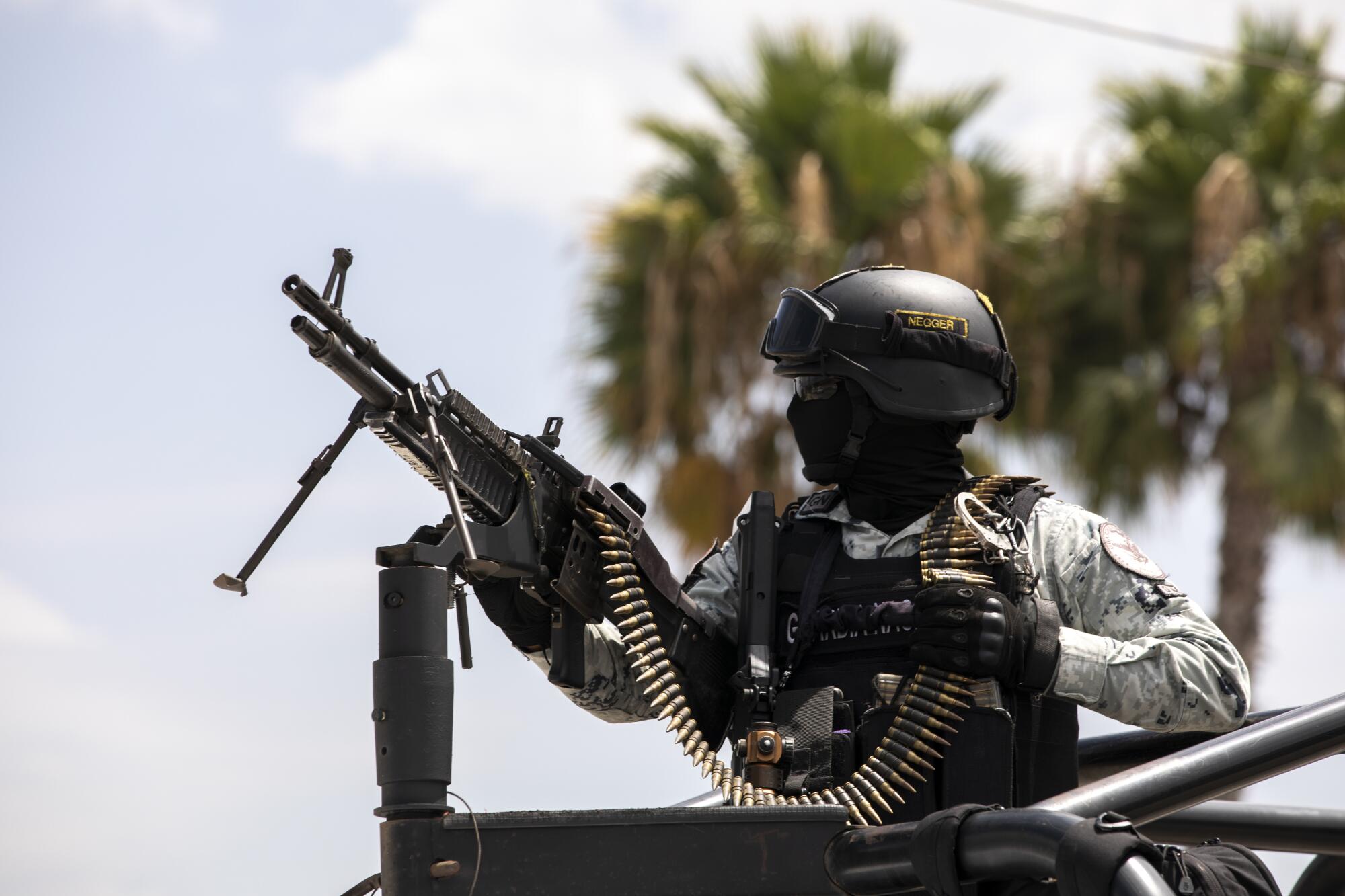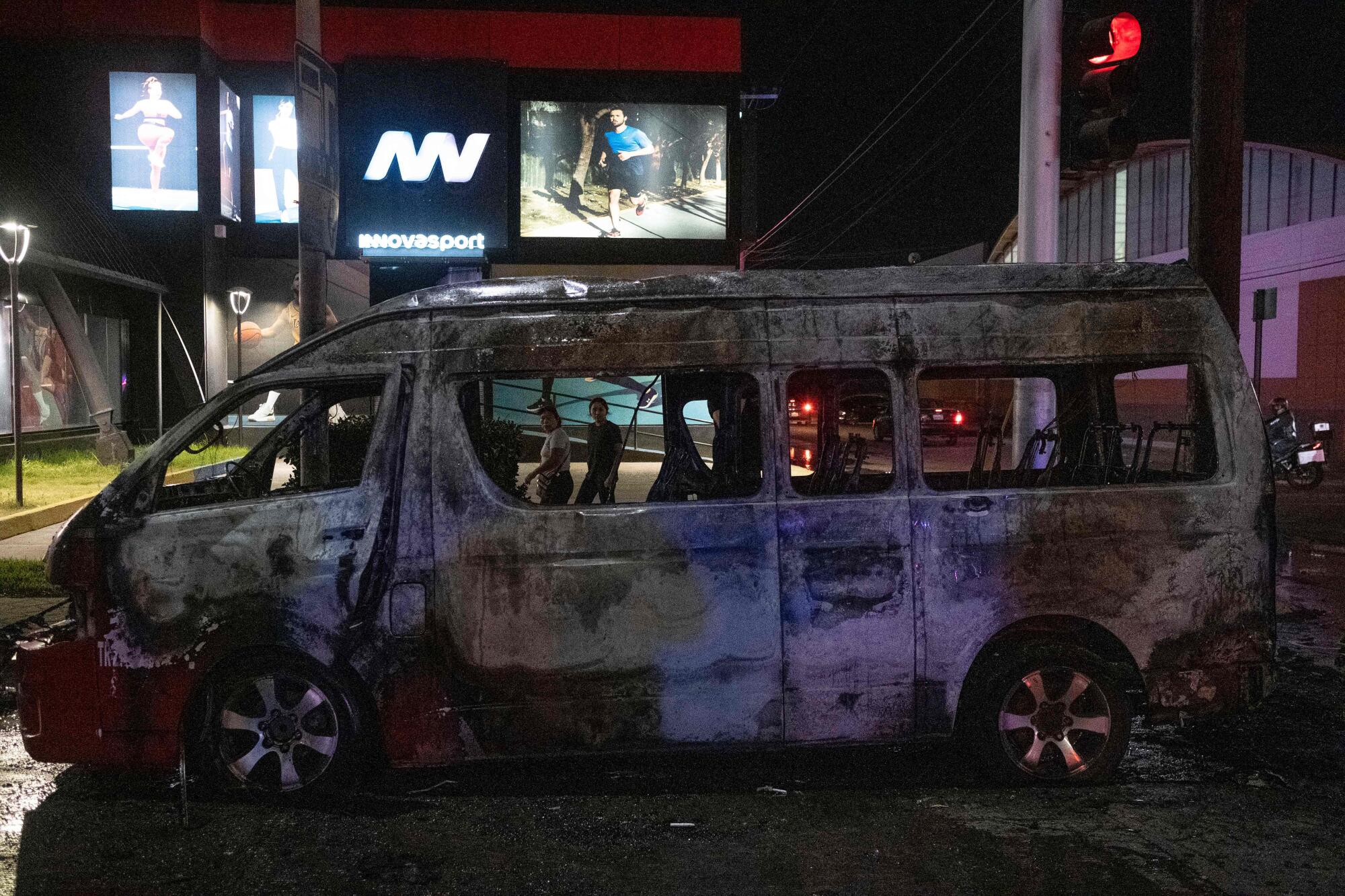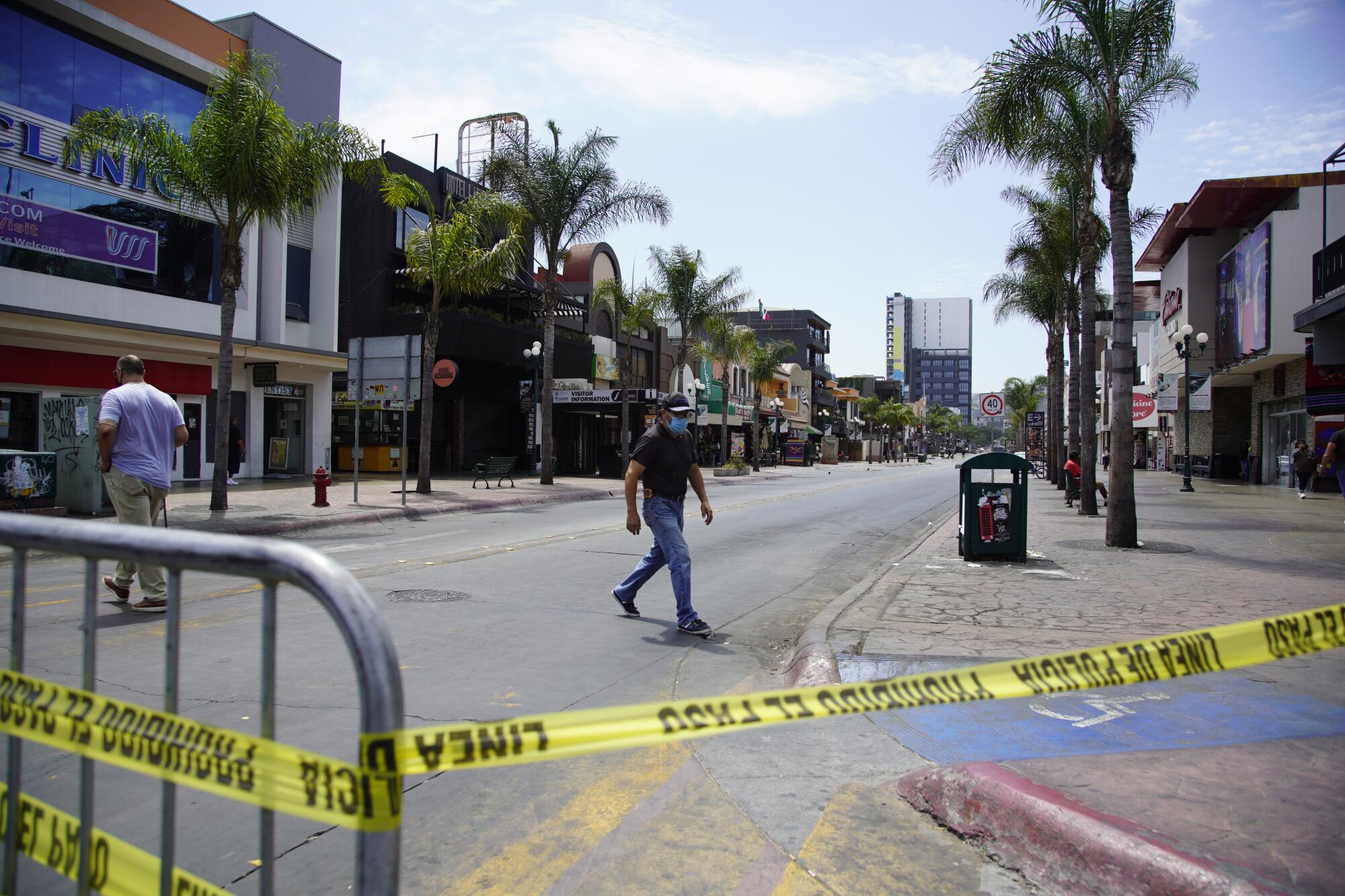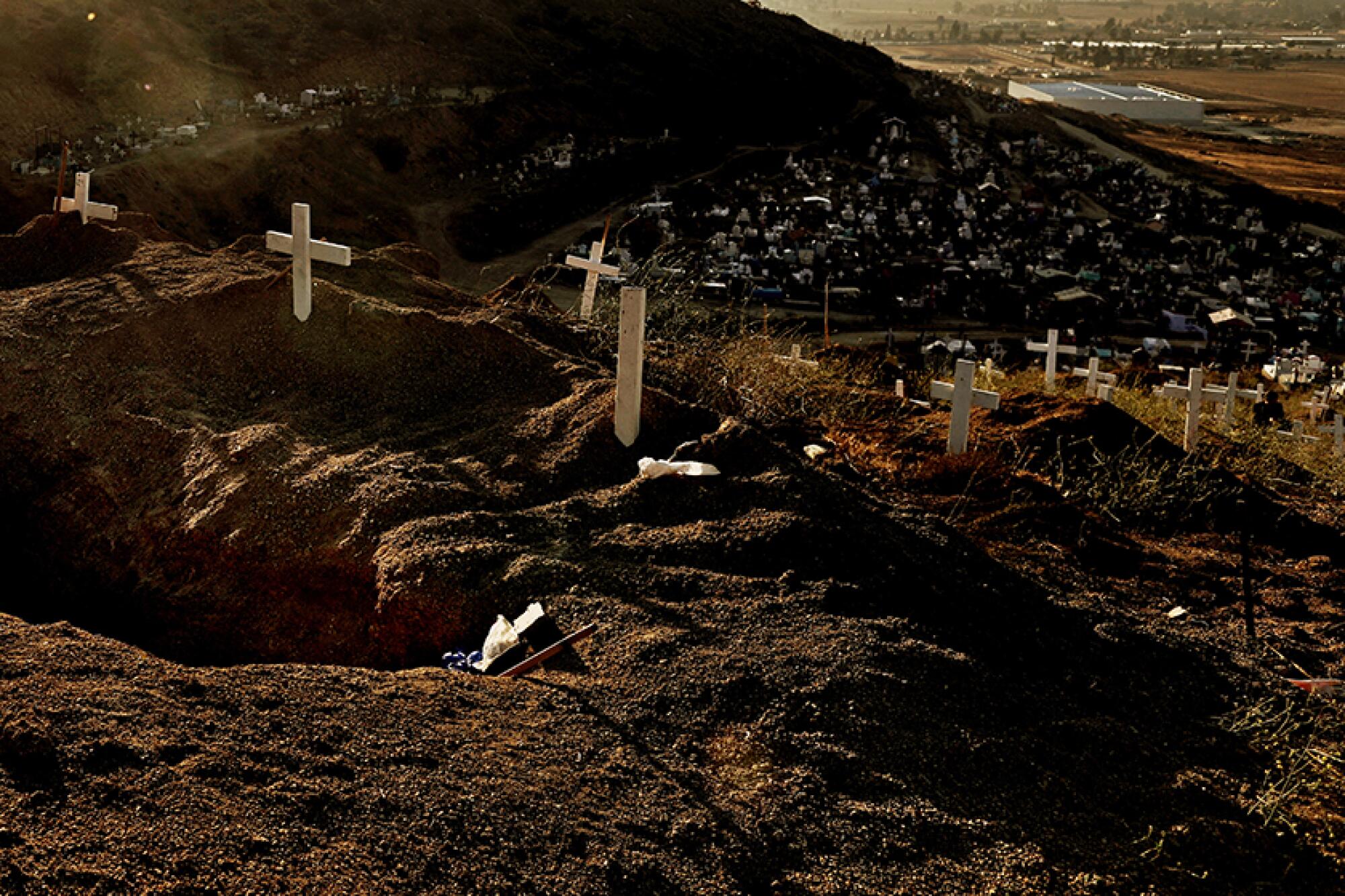
- Share via
TIJUANA — A week after criminals essentially shut down Tijuana and wielded gunfire and flames across other parts of the country, Mexican residents were left with lingering doubts about whether the chaos was over — as well as unsettling questions about who really holds the power, the government or the cartels?
The violent outbursts by hired low-level henchmen offered a reminder of the muscle and far reach of the Cártel Jalisco Nueva Generación, one of Mexico’s most vicious cartels, which officials have blamed for the attacks.
The string of attacks also revealed a glimpse into the government’s ability and determination — or lack of it — to respond.
This story is for subscribers
We offer subscribers exclusive access to our best journalism.
Thank you for your support.
At least 40 vehicles were stolen or hijacked and then burned around Baja California last weekend in a shocking and significant escalation of public violence across the border. Reports that the Jalisco cartel had declared a curfew in Tijuana also began to circulate online that Friday night, emptying many of the usually busy streets.
Although no one was killed in Tijuana, across Mexico 11 people died in the attacks, including a young boy and four radio station employees who were randomly shot on the streets of Ciudad Juarez, across from El Paso on Aug. 11.
Two days earlier in the northern state of Guanajuato, more than two dozen Oxxo’s, a well-known national chain of convenience stores, were set ablaze. Cars and buses were commandeered and burned in the neighboring Jalisco state.
Cecilia Farfán, co-founder of the Mexico Violence Resource Project, which is housed at UC San Diego’s Center for U.S.-Mexican Studies, said the attacks in Tijuana illustrated an important dynamic — that residents largely believe criminal organizations can successfully confront government forces in Mexico.
She pointed to the mass exodus from Tijuana streets Aug. 13, when most citizens went home, shuttered their businesses and left the Xolos game early as word of the cartel curfew threat quickly spread. Meanwhile, state and local officials tried to assure residents there was no official lockdown.
“What matters is people believe these criminal groups have the capacity to go to head-to-head with government authorities,” said Farfán. “They essentially said: ‘I’m not going to wait around to find out if it’s true or not. While you figure out if this is true or not, I’m going home.’”

Realities exposed
Mexican and Baja California officials are still trying to convince residents and tourists that the danger is over. Mexican President Andrés Manuel López Obrador was in Tijuana on Friday morning, highlighting his support for the Baja California governor and pointing to his administration’s quick response to the situation, which included making arrests and deploying more troops to the streets.
“She has our support and even more our sympathy. We have come to tell her that she is not alone, and that the federal government will always support her,” said López Obrador at a news conference on a military base in central Tijuana, which was surrounded by an unusually large presence of military and local police forces.
López Obrador seemed to boast about the government’s prompt response to the vandalism and fear, an echo to comments made by Gov. Marina del Pilar Olmeda and her top security officials earlier in the week when they said the criminals messed with the wrong state.
“As you know in recent days Baja California joined the states that have received confrontations from organized crime, but fortunately the criminals received a totally different response than what they expected,” said Pilar, stressing there was no loss of life in Baja California as there was in other regions. She also praised the quick work of state investigative authorities in arresting 17 people, which she said led to the subsequent arrests in Sinaloa of the suspected masterminds behind the attacks.


When faced with the threats the night of Aug. 12, Tijuana Mayor Montserrat Caballero took an unexpected tack, appealing directly to the drug cartel militias. She asked them to leave law-abiding citizens alone “and to collect bills [only] from those who did not pay.”
“Today we are saying to the organized crime groups that are committing these crimes that Tijuana is going to remain open and take care of its citizens,” Caballero said in a video. “And we also ask them to settle their debts with those who didn’t pay what they owe, not with families and hard-working citizens.”
She later defended her public message, saying she was talking to Tijuanenses, who knew what she meant.
Some experts and citizens took the comments to mean she wanted the criminals to keep the conflict between themselves. Others thought she was encouraging legitimate businesses to pay protection or extortion fees, so the night of terror would end.
Though Caballero drew widespread criticism for her comments, experts say her frankness revealed a unique reality: that a certain level of cartel violence and extortion has become a tolerated part of Mexican society, within reason.
Farfán described Caballero’s remarks as unfortunate.
“For a crime like extortion that is rarely reported, based on statistics, she’s essentially recognizing that it is quite widespread ... that it is an open secret in Tijuana ... which raises the question of what is your government doing about it besides just having a hotline for reporting extortion?” said Farfán.
Farfán said, perhaps more importantly, Caballero’s comments indicate there is an accepted second-class of citizens, as in “Those are criminals, who are no longer guaranteed the protection of the state,” she explained. That sentiment is often repeated by police officers who say “es entre ellos” — it’s between them — to describe crimes between citizens who seem to not matter as much to the state.
Caballero’s comments might have hinted at why the situation did not escalate beyond car fires in Baja California, as it did in other parts of Mexico, experts said, because if cartels wish to extract big extortion payments from businesses, then those businesses must continue to have customers who are not too terrified to go out and spend money.
Enforcing extortion is a double-edge sword, Farfán and others explained, and criminal groups must decide how aggressive they want to be before it hurts their bottom line.

Generating chaos
What exactly the cartel was aiming to achieve by its temporary takeover remains unclear, although there are theories.
Mexico has recently made more attempts to capture drug lords, something López Obrador previously said he wouldn’t do. Mexican marines captured fugitive drug lord Rafael Caro Quintero in July after years on the run for the 1985 killing of Imperial County DEA agent Enrique “Kiki” Camarena.
Also, Mexico’s seizures of meth labs and the synthetic opioid fentanyl have risen sharply in recent months.
The spark that set off the chaos in Jalisco and Guanajuato last week was apparently traced back to the moment when the military happened upon a meeting involving a boss from the Jalisco cartel. Gen. Luis Cresencio Sandoval, the national defense secretary, said the soldiers hadn’t known about it and were just trying to intercept a cartel convoy.
Others speculated the onslaught of attacks was prompted by the capture of Ricardo Ruiz, alias “RR” or “Doble R,” one of the top leaders of the CJNG in western Mexico. López Obrador now insists Ruiz was never captured.
During a news conference Wednesday, Baja California Atty. Gen. Ricardo Iván Carpio Sánchez said the goal of the CJNG locally was to incite panic and fear.

“It is precisely a propaganda event that is supposed to demonstrate that groups of people who operate underground can make decisions to instill this type of panic,” he said. He later added that the cartel paid its operatives wages of approximately 3,000 pesos or $150 for each car that they were able to burn last weekend.
He said those arrested are being charged with such crimes as property damage, arson and terrorism.
Mexico’s federal government, however, criticized the use of the word “terrorism” by the media. Interior Secretary Adán Augusto López said, “They are not terrorist attacks; you don’t have to exaggerate the facts.”
Mexican security analyst Alejandro Hope told the Associated Press he thinks chaos was the main point.
“Generate chaos, generate uncertainty, generate fear, shoot at anything that moves,” he said. “That is something that generates terror.”
But, Hope added: “Terrorism implies a political goal. I don’t know what the political goal is in this case.”
López Obrador, who is prone to espousing unfounded theories, wasn’t so sure politics wasn’t involved. He suggested Monday the attacks were part of a political conspiracy against him by opponents that he describes as “conservatives,” and he argued that “there is no big problem” with security.
“I don’t know if there was a connection, a hidden hand, if this had been set up,” he said.

Volatile battleground
The bustling streets of central Tijuana appeared returned to normal levels of activity Friday, with some residents having persistent doubt about whether the unrest was truly finished.
The whole region, which borders Southern California, is a lucrative trafficking corridor feeding the United States’ outsized appetite for drugs. The route was previously long dominated by the Arellano Felix cartel but has since become a battleground between various decentralized and fractured gangs, including factions of the Jalisco and Sinaloa cartels.
Nathan P. Jones, an associate professor of security studies at Sam Houston State University, pointed to an article by Héctor de Mauleón, a famous Mexican columnist, that described the Jalisco cartel as “la sombra que nadie vio” — the shadow that nobody saw. Jones said CJNG has been present and active in Tijuana at least since 2012.
“You can show that they’re present on some level, whether it be through alliances or contracts or something, in every state in Mexico,” said Jones.
He said particular attention should be paid to the relationships between low-level gangs that fight over turf in Tijuana and the larger criminal organizations vying for strategic control of the profitable trafficking route into California and the greater United States.
“You’ve got organized crime taking advantage of the disorganized crime market,” explained Jones. “There’s all these low-level criminals who will work for incredibly low wages, and they can be taken advantage of by organized crime. That appears to be the CJNG business model.”
More to Read
Sign up for Essential California
The most important California stories and recommendations in your inbox every morning.
You may occasionally receive promotional content from the Los Angeles Times.














